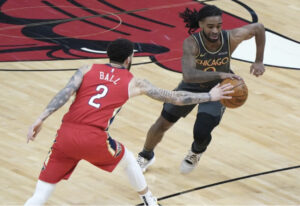In many ways, numbers greatly influence all of our days and ways: Interest, sales and income tax rates; unemployment percentages; dates when bills are due; birthdays, anniversaries; polls on this, that, and everything; ad infinitum. And lately, of course, the numbers associated with the Corona virus.
No wonder numerical analytics have become so popular throughout virtually every professional sport in America. And the NBA is certainly no exception.
However, the application of analytics to real on-the-court NBA action is misbegotten to the point of being utterly useless. Here are the basic relevant formulas.
PLAYER EFFICIENCY RATING (PER) – This is the total of a player’s positive stats minus his negative stats and given on a per-minute basis. This pays no attention to such positives as setting sturdy screens, timely defensive rotations, forcing an opponent to takea bad shot, getting back in transition defense, and other unregistered aspects of defense. Not to mention making the pass that leads to an assist pass, or making a cut that clears an area for a teammate to score.
POINTS PER POSSESSION (PPP) – Points scored by a player in isolations minus points scored when he’s playing screen/roll defense. What if the points scored when he’s playing screen/roll defense are due to misplays by the other defender involved? And what useful application does this number have anyway?
TRUE SHOOTING PERCENTAGE (TSP) – Total Points divided by 2(FGA + [0.44 x FTA]) x 100.
Say what? This formula is more complicated and more meaningless than a differential calculus equation.
FREE THROW RATE (FTR) – Free throw attempts divided by field goal attempts. Okay, so the more shots a player takes the more he gets fouled. So what?
USAGE PERCENTAGE (USG %) – This is supposed to evaluate the percentage and efficiency of those plays that involve any given player. The complicated equation involves a player’s minutes on the court, his field goal and free throw attempts, his turnovers, the team’s FGAs, FTAs, and TOs when he’s in the game, all subjected to various multiplications of either 100 or 0.44.Nurse! (And I don’t mean Nick.)
Every team in the league employs an analytics staff and supervisor. But several NBA coaches only pay lip service to the numbers these departments produce. One coach says, “The team spends a lot of money on analytics so I have to nod my head when I see the numbers. But in game preparation, making substitutions, and everything else that happen during games, I simply ignore them.”
Another coach says this: “All of these idiotic categories have one purpose only… To convince people who can’t tell an X from an O that they really do understand the game.”
Proponents claim it’s old-fashioned to gauge a player’s worth by watching him play. What they fail to note is that, to begin with, the watcher must truly understand what he’s watching.
This includes observing what a player does when he doesn’t have the ball, knowing what his function is in specific offensive and defensive sets, and understanding what his specific role is in relation to the four guys he’s playing with. Also, how he reacts in clutch situations and in blowout game as well as how hard he practices.
Indeed, the increasing reliance on analytics in the NBA is one significant reason why NBA action has become a made for TV spectacle.
In any case, numbers can never measure any player’s understanding of the game, his will to win and, most importantly his (and anybody’s) heart.





